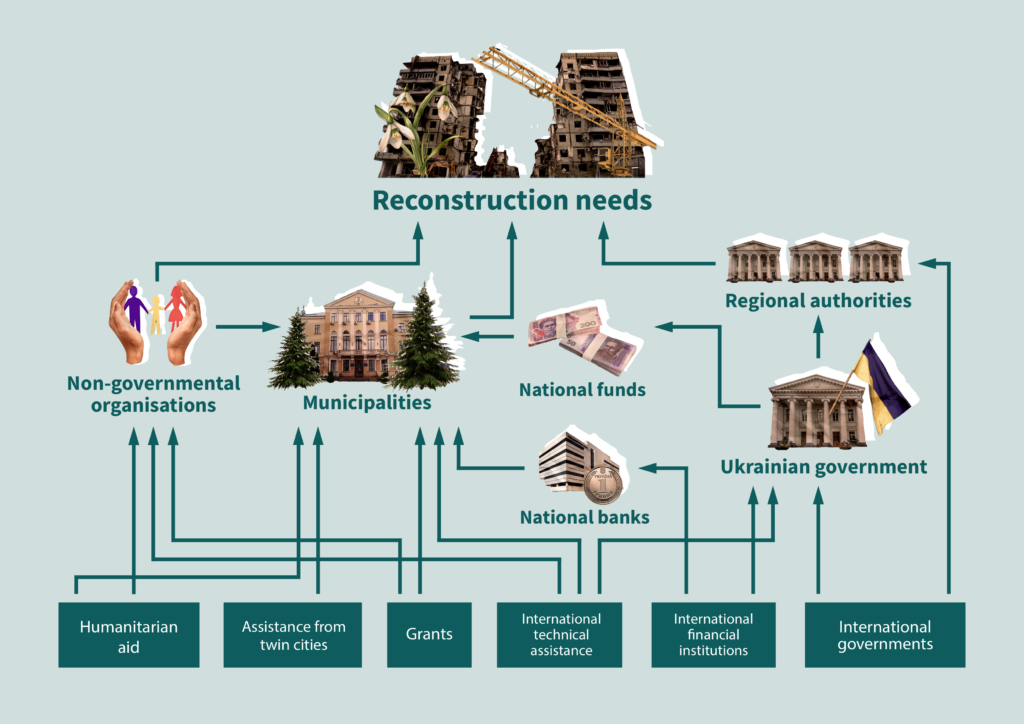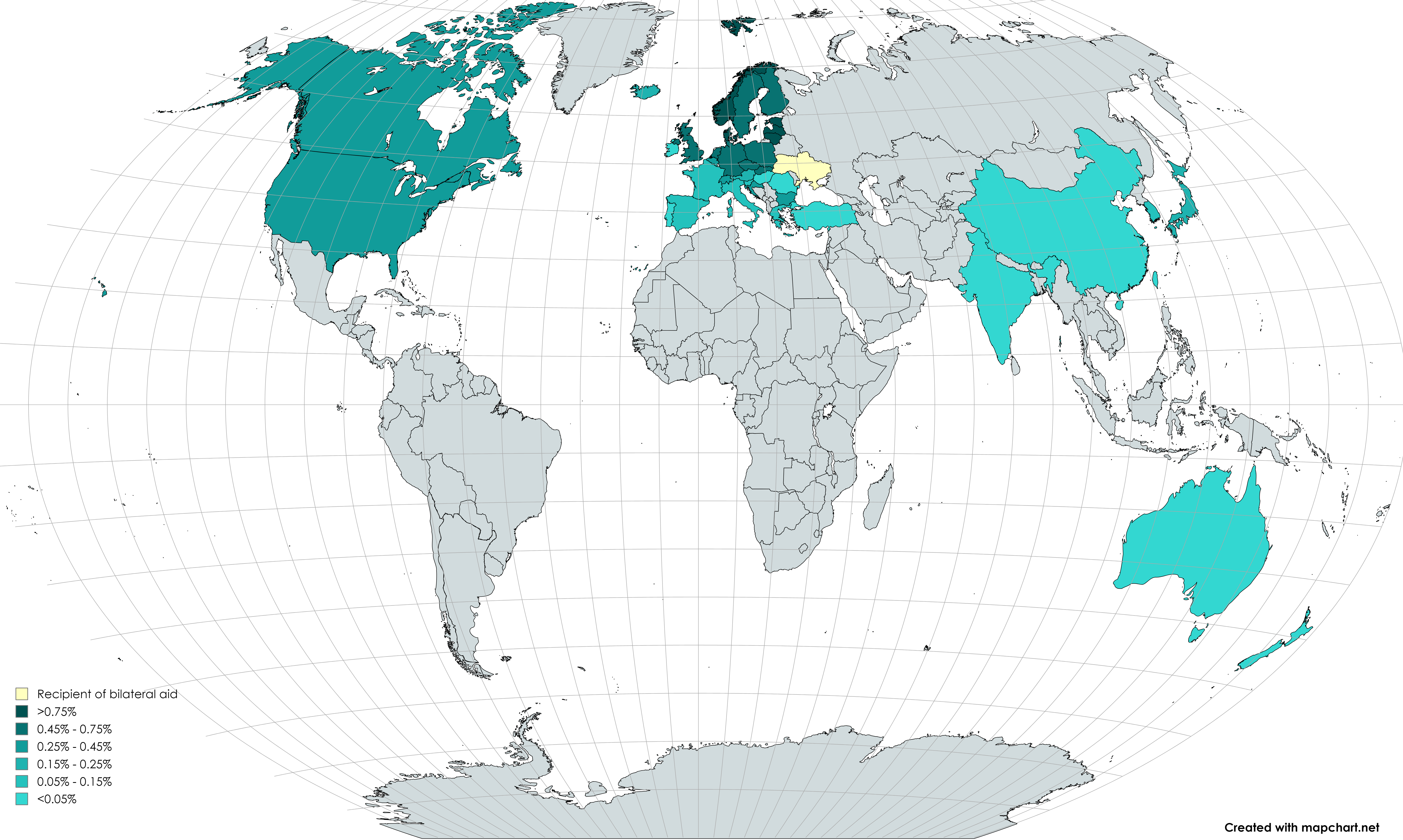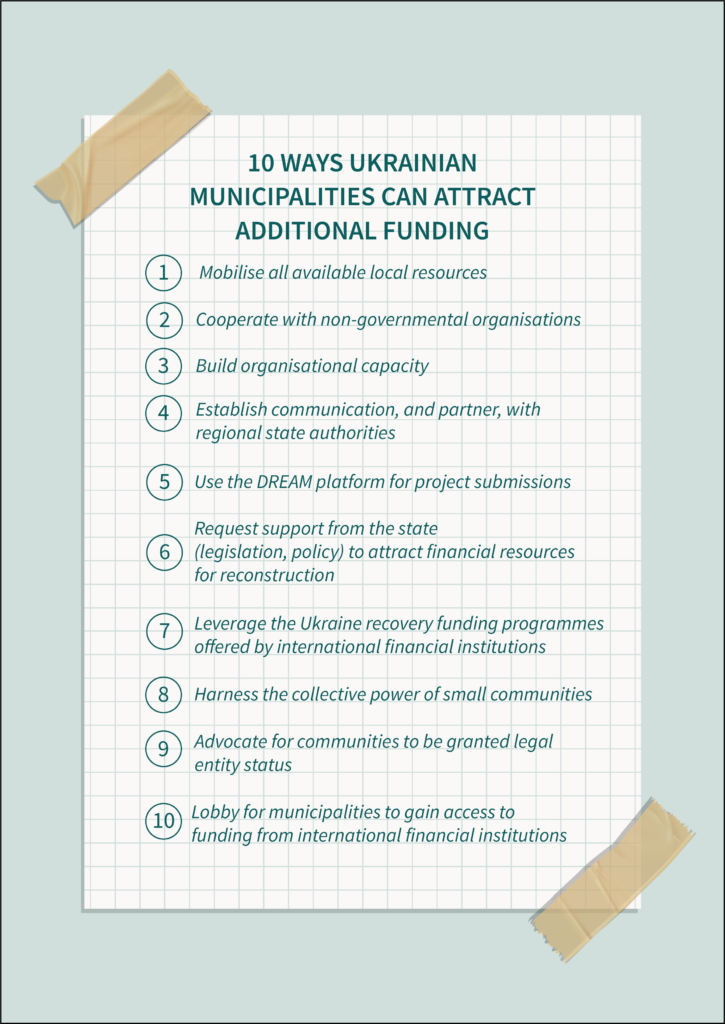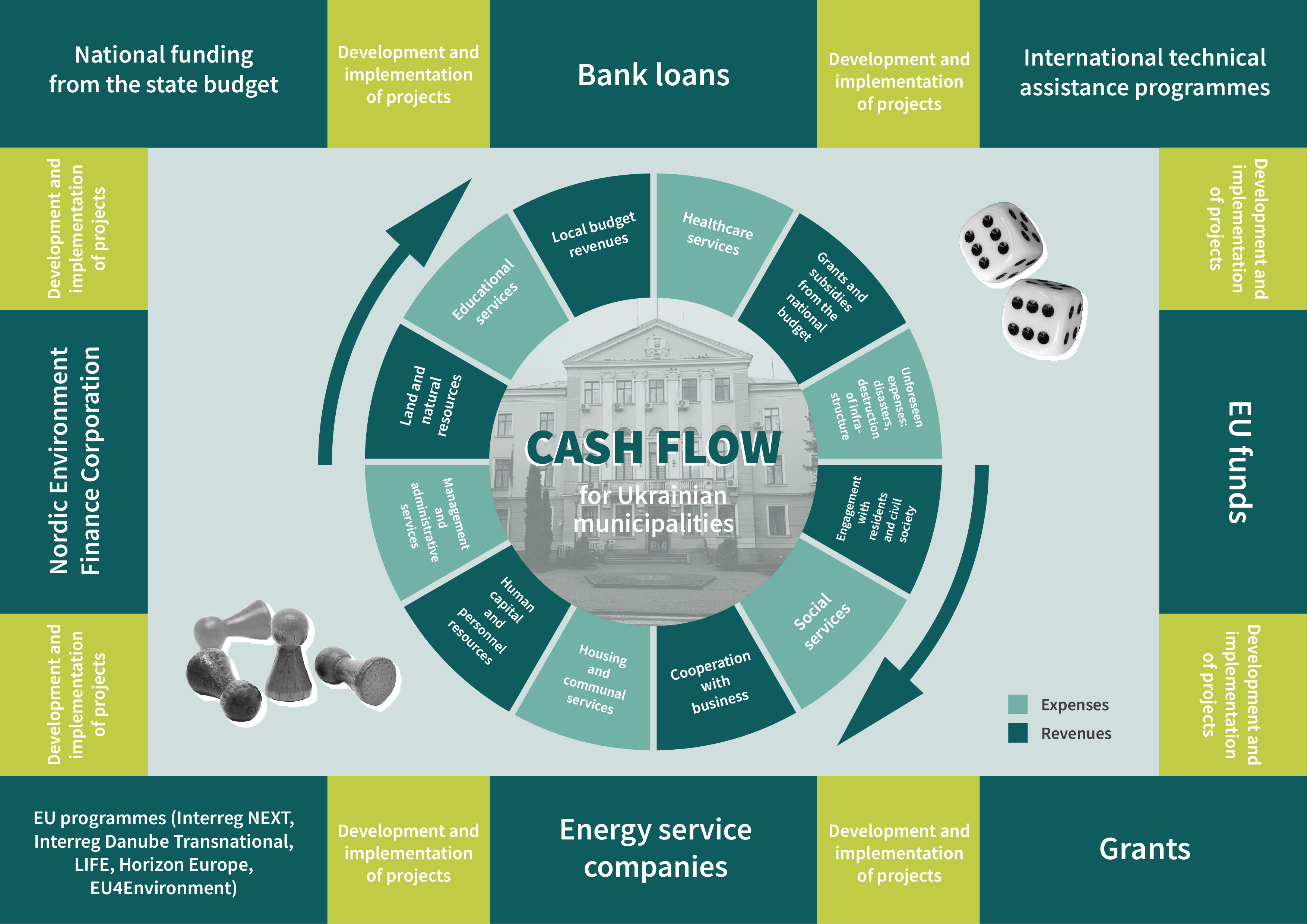Ukraine’s recovery on the ground: mapping financial resources and solutions for municipalities
by Mariia Lukyanova, Ukraine National Coordinator, CEE Bankwatch Network
Illustrative photo: Damaged building. Sofiia via Adobe Stock
In 2014, decentralisation reforms were introduced in Ukraine to increase the country’s resilience, empower local communities, and transfer more decision-making power from the central government to the local level. These measures have significantly helped communities keep their heads above water and respond quickly to the challenges of Russia’s invasion.
Since 2022, communities have faced the daunting task of dealing with the widespread damage to infrastructure and residential buildings caused by Russia’s military onslaught. The situation requires communities act quickly to mitigate the devastating effects of the invasion. But these challenges require additional funding, much more than usual. So where does the funding come from?

Humanitarian aid, support from twin cities, and international technical assistance programmes, including grants are the most accessible ways of attracting resources to meet the needs of municipal reconstruction. One way municipalities can maximise this access to humanitarian aid and grants is to partner with non-governmental organisations.
Local resources for reconstruction needs
First and foremost, communities use local budgets to fulfil their functions and delegate responsibilities. The revenue portion of local budgets consists of their own takings and transfers from the state budget. The more self-reliant communities have taken measures to increase their budget revenues by attracting investment, creating workplaces, promoting suitable conditions for business development, and inventorying community land banks. However, about three quarters of these communities are subsidised and depend on state budget support.
The war has increased differences in the financial capacities of communities, especially in frontline, occupied, and liberated regions that have suffered large-scale destruction and seen businesses and residents relocate to safer areas. At the end of 2023, state intervention in community revenues and the weakened the financial sustainability of communities. All in all, the uncertainties of wartime have significantly reduced the financial capacity of communities.
At the local level, active citizens, non-governmental organisations, charitable foundations, volunteer movements, and local businesses play key roles in helping municipalities meet their recovery needs. Volunteers and non-governmental organisations not only help to attract humanitarian aid and grants, but also act as partners to municipalities in cooperating with donors that have no direct involvement in organising budgets. Local businesses contribute significant amounts of their own resources to community reconstruction, hosting internally displaced persons, and relocating businesses. Active civil society strengthens local organisational capacity. That’s why cooperation with civil society along with public participation in local decision-making are so important in bringing about effective and inclusive local development.
State support for communities involved in reconstruction
The Cabinet of Ministers of Ukraine determines priority areas for state support of the country’s recovery, including mobilising finances and engaging with international partners. The Ministry of Communities, Territories and Infrastructure Development of Ukraine (also known as the Ministry for Restoration) is responsible for forming and implementing recovery policy in the regions and coordinating the work of line ministers on Ukraine recovery tasks. The State Agency for Reconstruction and Infrastructure Development of Ukraine (or State Recovery Agency) implements reconstruction projects at the national level, acting as an agent for individual local governments unable to fully implement projects.
The Ministry for Restoration is tasked with discharging national funds for reconstruction purposes. These funds include the State Fund for Regional Development (SFRD), the Energy Efficiency Fund (EEF) and the Fund for the Elimination of the Consequences of Armed Aggression. Because defence expenditure is being prioritised at the moment, funding from the state budget has not been allocated for the SFRD and EEF for 2024. This means that the survival of the EEF depends entirely on the financial support of international partners.
The difficulties communities had already faced in accessing funding from national foundations before Russia’s full-scale invasion in 2022 offer ample evidence of the need for two things: mandatory public participation within selection committees, and the involvement of international donors on the supervisory boards of these foundations.
Ukraine has taken some steps towards enhancing transparency and accountability, notably with the launch of the Digital Restoration Ecosytem for Accountable Management (DREAM). The platform is a one-stop-shop for communities seeking to submit projects, and enables donors and the public to track the progress and implementation of projects.
International funding for community reconstruction
To assist Ukraine in responding to Russia’s military invasion, financial support from international partners has increased significantly, quadrupling by the end of 2022. However, since 2022, almost all international support has been funnelled into the state budget, posing a major challenge for communities that desperately need to access international support to meet their reconstruction needs.
International financial institutions such as the World Bank Group, the European Bank for Reconstruction and Development (EBRD), the European Investment Bank (EIB), the Nordic Environment Finance Corporation (NEFCO), and others have launched special programmes to support Ukraine. However, they prefer to work directly with Ukraine’s relevant government ministries or Ukrainian banks. For example, the Ministry for Restoration has signed agreements with the EIB as part of the Ukraine Recovery Programme and Emergency Loan Programme for the Reconstruction of Ukraine, while the EBRD has provided loans to the state-owned bank Ukreximbank to assist private businesses and municipalities in Ukraine affected by the war.
However, international financial institutions typically work with large cities and regional centres, and have little or no experience of working directly with Ukrainian municipalities, which have an average population of 27,000. Currently, NEFCO is the most accessible of the international financial institutions for communities seeking funding to meet their green recovery needs. In addition to international financial institutions, international governments also provide direct support for the restoration of Ukraine’s regions.

How can municipalities attract more funding for reconstruction?
To attract more international finance for community reconstruction, local governments need to increase their organisational capacity in terms of project work to attract grants and EU funds, as well as financial management, especially of loans. Communities can increase their appeal in the eyes of donors by expanding the scope of their project proposals to include more than just one community. For instance, they can take the initiative and form intermunicipal partnerships, including with municipalities abroad, join community associations, and organising clusters involving businesses and universities.
The role of the state in these processes is also crucial, as it can provide a regulatory framework for municipalities to attract external funding. Some positive steps have already been taken. At the end of 2023, the Budget Code of Ukraine was amended to allow rural and suburban communities to obtain loans. But to build on this initiative, the administrative procedure for legalising intermunicipal partnership agreements now needs to be simplified. Another welcome development would be to strengthen the legal framework for public–private partnerships. This would protect municipal properties and assets from hostile business takeovers and shield businesses from assuming project risks.
Sharing limited financial resources and a common enemy in Russia, the last thing Ukrainian communities should have to do is compete for funding. Instead, regional government agencies should take a proactive role in attracting joint funding that supports the strategic development goals of all communities in the regions. This might involve harnessing the potential of existing regional development agencies and recovery offices.
International financial institutions must also step up to the plate. Reviewing their financial policies to make funding more accessible to Ukrainian municipalities would be a major step forward. On this point, civil society organisations, community associations, and the government should continue to advocate for international financial institutions to overhaul their approach to local funding.

From rat race to fast track: Ukrainian municipalities and the game of Cashflow?
The second phase in Ukraine’s decentralisation reforms ended at the end of 2020. Since then, municipalities have had to rely on their own resources as they scramble to obtain additional financial resources and delegate responsibilities, challenges exacerbated by the post-COVID recovery and war with Russia. Even in times of peace, municipalities had faced an uphill battle in securing resources to ensure sustainable social and economic development within their territories in line with the course of European integration. In other words, the challenges and restrictions linked to the full-scale war mean that municipalities now have to play a different game if they want to attract funding.

Just like in the popular financial board game Cashflow, municipalities have to escape the rat race (inner circle) and hop on board the fast track. To do this, they have to progress from the inner circle, where they are limited by local revenues and expenditures, to the outer world of global investment. Of course the aim of the game is to attract additional funding for the development and implementation of new projects.
At the local level, municipalities operate within their local budgets, which are topped up with revenue from local taxes and fees, grants and subsidies from the national budget, income from land and natural resources, human capital, and personnel resources. As well as attending to the needs of businesses, residents, and civil society organisations, municipalities need to make sure they have enough money for essential services such as education, healthcare, social welfare, management and administration, housing, communal services, and unforeseen expenses incurred as a result of disasters and infrastructural damage.
The sticking point for municipalities, especially those involved in reconstruction projects, is that this level of financing is nowhere near enough. This is where external funding comes into play. But to access these opportunities, municipalities must invest considerable time and effort in building their organisational capacity, particularly their project and financial management skills and capabilities. For this to happen, it’s vital that they establish strong relationships with other communities, regional authorities and, crucially, international donors and partners. The steps outlined above serve as a roadmap for municipalities looking to break free from the limitations of local budgets and achieve their reconstruction goals.



